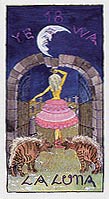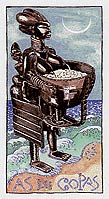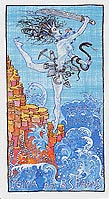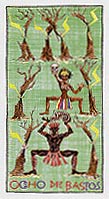Tarot Lukumi Deck Review
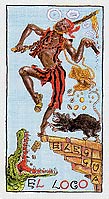
Creators: Caelum Rainieri, Ivory Andersen, Raphael Montoliu
Publisher: Dal Negro
The Tarot Lukumi is dedicated to Santeria, the Afro-Cuban Orisha Spiritual system known to its practitioners as Lukumi.
Retailers
This deck is rare or out of print and isn't easy to find. Search for it on eBay or Amazon.com, or browse our most popular Tarot decks.Tarot Lukumi Review by Djenra
The Lukumi Tarot shows events from the legends and stories of the Spiritual Intelligences who are the Orishas of the Lukumi pantheon which is called La Regla Ocha or La Regla Lukumi. (Regla means "rule" as in the rules of a practice or a religious way of life.) The person who conceived of the deck Emanuele Guidi has had the artist, Luigi Scapini (artist of The Medieval Tarot and The Stained Glass Tarot) use the faces of people actually in his religious life for some of the Orisha shown in the deck. The artist's technical style is excellent.
This deck is a first in many ways. Unlike the Tarot of the Orisha's this is a full sized Tarot deck, and unlike the New Orleans Voodoo Tarot it deals specifically with the Afro-Cuban traditions of the Lukumi people in Cuba. Afro-Cuban Lukumi is in itself a mixture of influences which include the Kongo, Yoruba, Catholic and even some Arada or Vodoun influences.
This is a 78 card Tarot deck. The cards are standard size but perhaps a touch longer or taller than most decks. They are well crafted and laminated and shuffle well. The cards are titled in Spanish. The four suits are: Bastos for Wands, Copas for Cups, Espadas for Swords and Oros for Coins. The court cards are: Rey, the King; Reina, the Queen; Caballo, the Knight and Sota for the Page. The back of the cards is a brillant shade of ruby red and shows an image of a two faced Elegba, one side brown and smooth skinned and young and the the other side a gnarled and bearded black old man a row of cowrie shells runs like a river between the two faces. The back design is completely reversible.
The deck comes in a box which includes a good sized booklet. The picture and the colors of the box make it light, bright and attractive. The box has on its front one a beautiful image which is also the frontspiece of the deck and the booklet - a picture of the Elekes and the Warriors. The first initiation of La Regla Lukumi is the receiving of the Collares (Spanish) or the Elekes (Yoruba). The Elekes Warriors are received as a shield and the Warriors or Guerreros (Spanish) as a protection by one who enters into the Lukumi tradition. They serve to alert them to the the unseen forces as well as the obvious dangers in life.
The Major Arcana have changed their titles as they are in Spanish, but in general they stick to the concepts and to the format of traditional decks over which is superimposed and added to each Major, the visage and the symbols of the Afro-Cuban Orisha. The images depicted on the Minor Arcana are scenes from the pataki's, the stories of the Lukumi passed on by an oral tradition, it is here that the deck does not follow in any way the artistic format or content of Rider-Waite deck.
The overall beauty of this deck is the function it serves. This is a deck that was prayed for by the community of Spiritualists, priests and initiates of the faith who use the Tarot in their work with clients and each other. The need for this Tarot was great. It is not a Tarot to collect dust way up on a shelf. It is a Tarot that was made to be used. It was made because the practitioners and their Spirits though used to adaptation, did not feel really comfortable with the Tarot tools they were using.
The only short coming is that a full sized book was not released at the same time as this deck which though it contains a good sized booklet in the box, must use the majority of the space in said booklet to repeat the basic information on the background of the Lukumi faith and the cards in the three languages of Italian, English and Spanish which cuts down on the amount of actual space given to providing even a cursory meaning for each card.
When the deck was opened and asked to state its purpose in the world, it responded with Seis de Copas, the six of cups. This card shows a scene of the Eldest of the Orisha arranged around a Star of David, each drinking from a goblet shaped clear glass a red liquid. In the center of the scene is an alchemical pelican with six small chicks with open mouths taking in their food. As one can see this has nothing to do with the traditional 6 of cups meaning, so one must go to the booklet where according to the author of the deck this is said to be a card "about harmony and brotherhood."
Those who do not know the qualities of the Orisha and their stories which the booklet goes over all too quickly and briefly when at all, might find themselves at sea. They will not be able to interpret the cards based on the scenes on them, unless they reach down into their intuitive, imaginative or psychic selves. This is a new Tarot deck and each deck is a world unto itsef. New meanings need to emerge for each card in the Lukumi Tarot based on the principles of the Lukumi religion and culture.
Tarot Lukumi Review by Oshuniyi Odofemi
The Tarot Lukumi by Luigi Scapini and Tata Emanuele Coltro Guidi is the first Tarot Deck dedicated entirely to the Afro-Cuban Orisha Spiritual system known the world over as Santeria, and to its practitioners as Lukumi. There have been attempts before in placing the Orishas in Tarot, such as the Tarot of the Orishas, which to the Orisha community was a big disappointment. Then the Orishas, where featured in the New Orleans Voodoo Tarot, and although that deck is quite beautiful, let it be known that Lukumi is not Voodoo and it was a bit weird that the Orishas where placed in that deck. Also not to mention that both The Tarot of the Orishas, and The New Orleans Voodoo Tarot, are not traditional Tarots, in the sense of the word.
The Lukumi Tarot, is just that, a true Tarot deck, that is a feast to the eyes, and pleasant enough that both the Orisha community as well as the Tarot community can enjoy this deck.
Although it stays true to the tarot system, one must understand that, each card is dedicated to an Orisha, an Elder in the religion, or a certain Patakis of the religion. If you do not have the basic knowledge of these things, you will be lost. Reason being, most of the cards are based on Pataki, these are sacred tales that are the body and wisdom of the religion. Each Pataki is a tale that explains the life of an Orisha, or a situation in the Orishas life that teaches moral lessons, as well as explain why things are. This is apparent in many of the cards. Such as the Enamorados, "the Lovers" which depicts the tale of Chango, Ochun and Obba. And how Ochun tricked Obba into slicing her ear and placing it into Chango's food. If you know this ancient tale, then the interpretation to that card will come clear to you. Sadly to say the small booklet that comes with the Deck really does not go into explaining much of these things. So the person who has little knowledge of Orishas, as well as the average Tarot reader will be a bit lost. It is not that the booklet that comes with the deck is bad, it is okay, and with it you can learn to read the deck. But if you had more knowledge in the Sacred Patikis many of the cards would come clearer when interpreting them.
The Tarot Lukumi is average size, a bit thinner that regular Waite Tarot, and so they fit small hands well, and shuffle great. The coating of the cards is a bit on the thin side, but durable. The back of the deck is a red background showing the believed Ancestors Santero and Santera, Negro Fransisco and Negra Thomasa, separated by Cowrie Shells and they are reversible.
There are 22 major Arcana, are is Spanish as are the Minor Arcana and they are as follows.
El Loco "Eleggua" = The Fool
El Brujo "Nganguero" = The Magician
La Sacerdonsa "Iyami Horonga" = The High Priestess
La Emperatriz "Ochun" = The Empress
El Emperador "Chango" = The Emperor
El Somo Sacerdote ‘Orunmila" = The High Priest
Los Enamorados = The Lovers
El Carro "Iyawo" = The Chariot
La Justicia "Ogboni Edan" = Justice
El Ermitano "Babalu Aye" = The Hermit
La Rude de Fortuna "Opon Ifa" = Wheel of Fortune
La Fuerza "Oya" = Strength
El Corgado "Oba Koso" The Hanged Man
El Baron Del Cemeterio "Iku" = Death
La Templanza "Olokun" = Temperance
Olosi = The Devil
La Torre = The Tower
La Estrella "Yemaya Asesu" = The Star
la Luna "Yewa" = The Moon
El Sol "Olo Orun" = The Sun
Jucio Final "Egungun" = Judgement
El Mundo "Lucero Mundo" The World
The Minor Arcana are in Spanish and they are Bastos, "Wands" that depict Ancestor Staffs, Arrows, and Osain herb sticks. The Espadas "Swords" depict machetes, and swords. The Copas, ‘Cups" depict Tureens, Cups, Bottles, and Gourds. Finally Oro, depict coins.
Warning.. The deck is true to Lukumi in that many of the elements are there, and nothing was swept under the rug. In the cards 5 of Wands, the card depicts a rooster being sacrificed to the Warrior Orishas. 6 of Wands depict the Orisha Ochosi holding a prize hunted Deer with arrows in its body and blood dripping down. 4 of Swords depict Oggun thinking after he had decapitated some human's heads and hung them on trees. 3 of Swords depict Oggun getting caught buy Obatala after he rapes the Orisha Yemmu. Lastly 6 of Swards depicts human possession, and this card is so powerful that many who do not understand Orisha possession will find it a bit disturbing.
The Lukumi Tarot have the typical King, Queen, Knight, and Page, but as the other cards they are in Spanish. Rey, Reina, Caballo, and Sota. Some of the Queens are seen as the Catholic Saints that are respected in Santeria Lukumi, such as Santa Barbara, who is venerated as Chango, and Our Lady of Charity who is honored as Ochun. Many Catholic Saints have been a great part in preserving the Orishas in the Americas, so this was needed.
The Orishas, Saints and people in the deck are Africans, Mulattos, Taino Indians, and European, so this deck will appeal to almost everyone. The cards come with a small little booklet the explains the interpretation of the cards in Spanish, English and Italian. But honestly it would be more beneficial if an accompanying book would be published such as the ones that came with the New Orleans Voodoo Tarot, and The Tarot of the Orishas.
In closing I was a bit on the iffy side when I read that Luigi Scapini was doing this deck, I have his Medieval Tarot and I had seen his Stained Glass Tarot. Booth are beautiful, but I could not imagine his art is an Afro-Cuban flair. But let me say, I stand corrected, Luigi Scapini is a genius, at viewing this deck one would say he was an Initiated Santero for years. Which I believe he is not.
I highly recommend this
deck, for both the collector as well as the reader, it
is one of those decks you will probably be seeing
most Latinos use, but if you have an interest in
Santeria and love the Orishas, this deck is an excellent
addition. I do not recommend this deck to the beginners, or
those who do not like graphic scenes, as well as some
nudity. All in all this is a very refreshing deck, that
is receiving a lot of notability, not just in Lukumi,
but also within all the other Orisha traditions.
Complete Details of Tarot Lukumi
Creators: Caelum Rainieri, Ivory Andersen, Raphael MontoliuPublisher: Dal Negro
Deck Type: Tarot Deck
Cards: 78
Rating: 14/20 or
Similar Decks to Tarot Lukumi
Theme: AfricanCreator: Nahualli Animal Oracle by Raphael Montoliu Nahualli Animal Oracle by Ivory Andersen Nahualli Animal Oracle by Caelum Rainieri
< Previous Deck · Back to Top · Next Deck >
Home > Tarot Reviews > Tarot Lukumi Review

